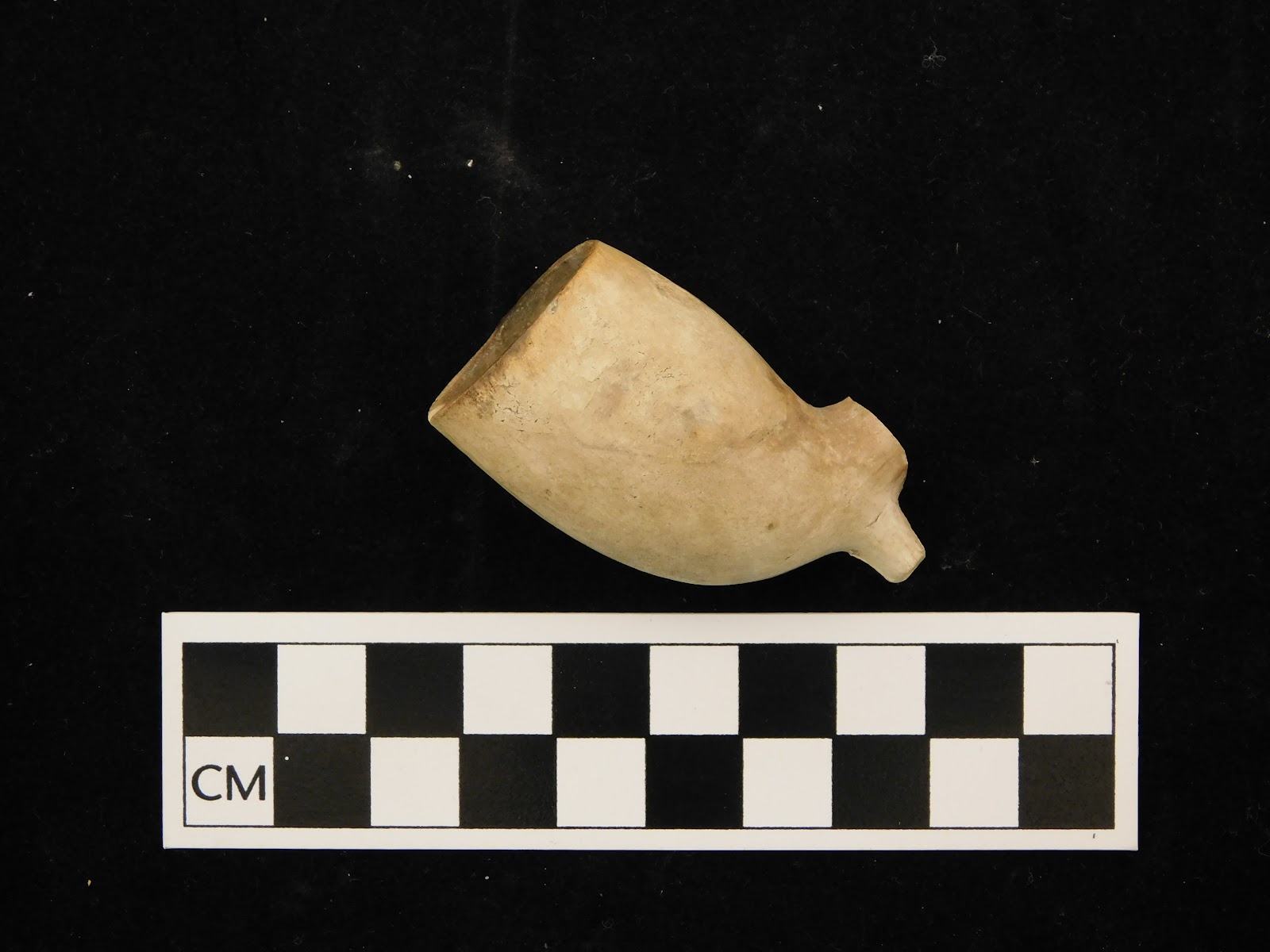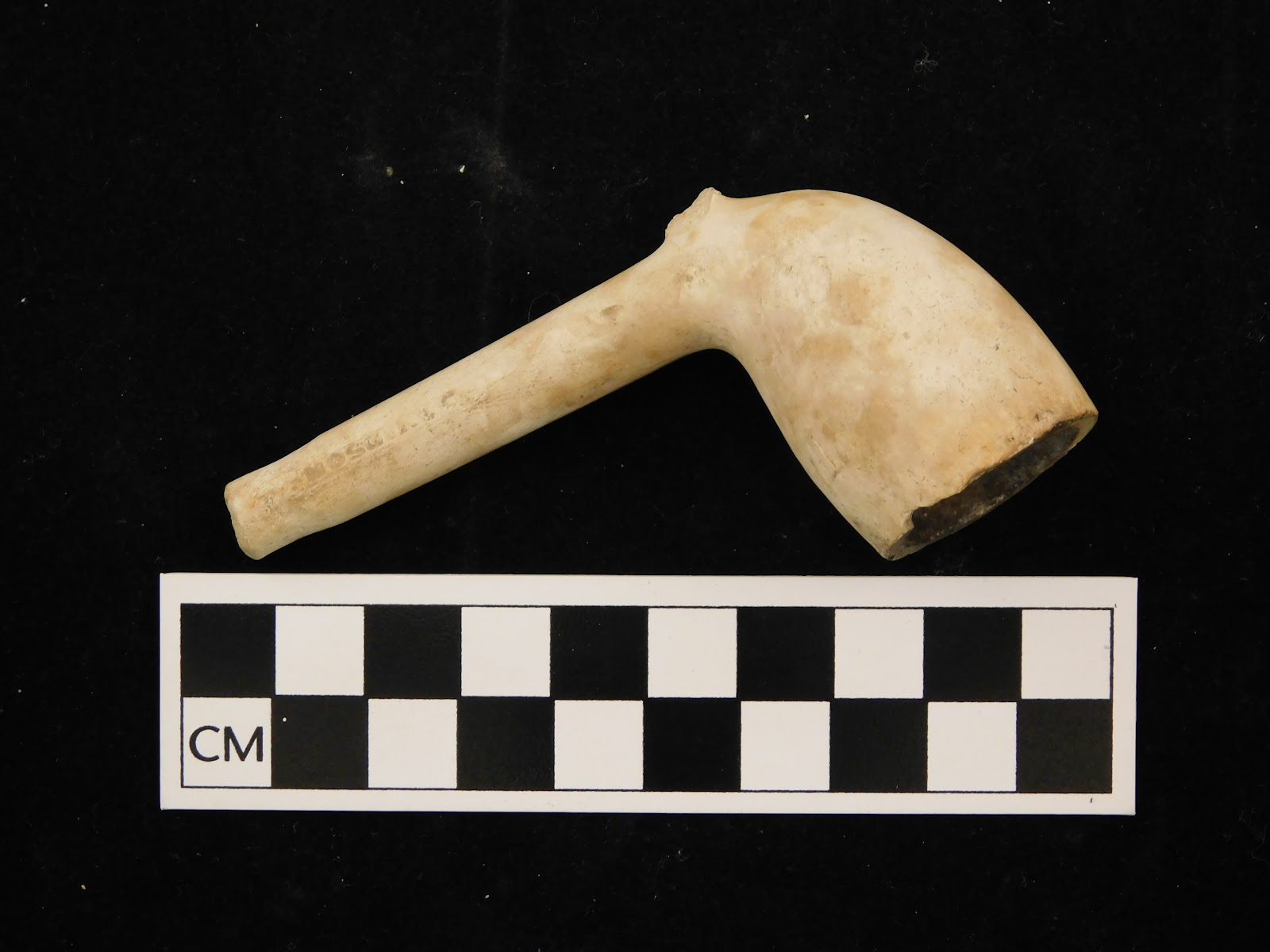Clay Pipe Fragments and the Colonial Tobacco Trade
Hello everyone, my name is Peter Philbin, and I just finished my first year at Bates College. I will be taking Archeology 101 this fall, and my main field of study is in the Classical and Medieval Studies department. Having had no real experience with an archaeological dig or lab, I was very excited to participate in the Strawbery Banke Field School. The dig and subsequent lab work has proven to be both exciting and informative, and I would love to do more work in archaeology in the future.

An example clay pipe, dated between 1580 - 1610
My work for the lab session was focused on the clay pipe fragments found at Sherburne House. Previous research had been done at the Yeaton-Walsh House site (SB24), where 259 pipe stems were recovered, measured and analyzed. I decided to measure as many pipe stems as possible from Sherburne House and compare the dates of use across both houses. The chief issue with collecting this data for Sherburne House was the sheer quantity. In total, I measured and date 462 pipe stems, but an unknown number remain unmeasured and undated. To try and ensure that accurate data was being recorded, I first measured 262 pipe stems and recorded the results. I then repeated this process for 200 additional pipe stems and found nearly identical trends in the respective eras for the pipe stems, leading me to believe that the data collected is representative of the total pipe stems at Sherburne House. The greater number of pipe stems at Sherburne is likely explained by the high status of the Sherburne family as well as the house’s age.
With this information, I returned to the information found at Yeaton-Walsh and compared our findings. The results revealed some broad trends in the smoking habits of Strawbery Banke residents. The bar graph below shows what percentage of the total number of pipes for each house belonged to a given era based on their stem measurement:

Here, we can see that the plurality of pipe stems at Sherburne and a slim majority of stems at Yeaton-Walsh were dated to between 1720 and 1750. This trend can likely be explained by the respective growth of the American tobacco industry. Virginia began importing a much greater number of slaves during the 1680s and 1690s, and the result was a boom in the international tobacco trade. The beginnings of the wider availability of tobacco are exhibited in the pipe stems from 1680 and 1720. Sherburne House was constructed around 1695, and thus was in use before the land where Yeaton-Walsh now stands. Yeaton-Walsh was not constructed until 1803, but the land was in use throughout the 1700s as Marden’s Mast Yard. Sherburne’s earlier founding date likely explains the 6 point difference in pipe stems from 1680 to 1720, as well as the greater number of pipe stems found at Sherburne that predate 1680 (10 in total at Sherburne, 2 at Yeaton-Walsh). The peak of the tobacco boom came during the 1730s, when using a clay pipe was a common feature of aristocratic life for the English. The drop off in totals for stems dated from 1750 to 1800 is likely the result of trade turbulence during the American Revolution and its aftermath, as well as the gradual abandonment of clay pipes as an aristocratic symbol.
I have also included some photographs of the more interesting artifacts found in the collection, including pipe bowls and stems with engravings and one pipe with the bowl and stem connected. I’d also like to thank Alix Martin and the Strawbery Banke staff for this amazing opportunity. Enjoy the findings!







An example clay pipe, dated between 1580 - 1610
My work for the lab session was focused on the clay pipe fragments found at Sherburne House. Previous research had been done at the Yeaton-Walsh House site (SB24), where 259 pipe stems were recovered, measured and analyzed. I decided to measure as many pipe stems as possible from Sherburne House and compare the dates of use across both houses. The chief issue with collecting this data for Sherburne House was the sheer quantity. In total, I measured and date 462 pipe stems, but an unknown number remain unmeasured and undated. To try and ensure that accurate data was being recorded, I first measured 262 pipe stems and recorded the results. I then repeated this process for 200 additional pipe stems and found nearly identical trends in the respective eras for the pipe stems, leading me to believe that the data collected is representative of the total pipe stems at Sherburne House. The greater number of pipe stems at Sherburne is likely explained by the high status of the Sherburne family as well as the house’s age.
With this information, I returned to the information found at Yeaton-Walsh and compared our findings. The results revealed some broad trends in the smoking habits of Strawbery Banke residents. The bar graph below shows what percentage of the total number of pipes for each house belonged to a given era based on their stem measurement:
Here, we can see that the plurality of pipe stems at Sherburne and a slim majority of stems at Yeaton-Walsh were dated to between 1720 and 1750. This trend can likely be explained by the respective growth of the American tobacco industry. Virginia began importing a much greater number of slaves during the 1680s and 1690s, and the result was a boom in the international tobacco trade. The beginnings of the wider availability of tobacco are exhibited in the pipe stems from 1680 and 1720. Sherburne House was constructed around 1695, and thus was in use before the land where Yeaton-Walsh now stands. Yeaton-Walsh was not constructed until 1803, but the land was in use throughout the 1700s as Marden’s Mast Yard. Sherburne’s earlier founding date likely explains the 6 point difference in pipe stems from 1680 to 1720, as well as the greater number of pipe stems found at Sherburne that predate 1680 (10 in total at Sherburne, 2 at Yeaton-Walsh). The peak of the tobacco boom came during the 1730s, when using a clay pipe was a common feature of aristocratic life for the English. The drop off in totals for stems dated from 1750 to 1800 is likely the result of trade turbulence during the American Revolution and its aftermath, as well as the gradual abandonment of clay pipes as an aristocratic symbol.
I have also included some photographs of the more interesting artifacts found in the collection, including pipe bowls and stems with engravings and one pipe with the bowl and stem connected. I’d also like to thank Alix Martin and the Strawbery Banke staff for this amazing opportunity. Enjoy the findings!
Comments
Post a Comment